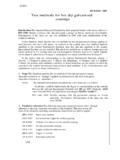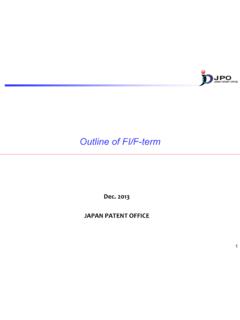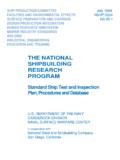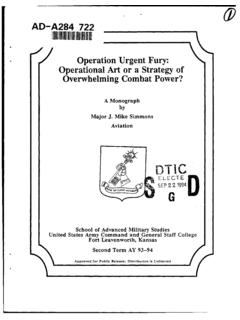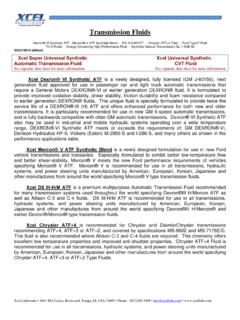Transcription of Issued December 1 - ThreeBond
1 113 Three Bond Technical News Issued December 1, 1985 Temperature Classes of Electrical Insulators Shimizu Ohta 1. Introduction In early times, the temperature classes of electric insulators were simply divided into natural organics, inorganics, and combinations thereof. In the late 1930s, the types of synthetic resins became diverse and their production volumes increased, with their application range being gradually expanded to insulation. In the late 1940s, when silicone resin became a popular insulator material, the H-class insulator was added to the temperature classes, and it became increasingly necessary to find applications for heat resistant materials in electric instruments.
2 Under such circumstances, IEC1) Issued a recommendation on the temperature classes of electric insulators, followed by IEC Publication 852) (1957), which established the classification system currently in use. In Japan, JEC 1473) (1957), which was prepared by the japanese Electrotechnical Committee, and JIS C 4003 (established in 1962, revised in 1977, and confirmed in 1982), which was prepared by the japanese industrial Standards Committee, contain material-classifying tables as a reference. In parallel, the evaluation method for insulator classification was established, and some testing techniques for the high temperature life of new material for temperature classification were investigated intensively in the United States.
3 The results were Issued in many IEC ) Such investigation has been continued to find a short time testing method of high temperature life. This paper reviews the temperature classes of electric insulators. Contents1. Introduction ..12. Insulation classes for electric equipment23. Temperature classes of materials used for various Testing method of high temperature life for various Temperature classifications used in other 5-1. japanese National Railways Standard (JRS) ..6 5-2. Relative-temperature index used in UL Electric-apparatus regulations and using temperature of 8 <References> .. 8 Fine chemical products for optical communications .. 9 Introducing high performance chemical products for electronics.
4 10 2 2. Insulation classes for electric equipment In 1977, the Electric Instrument Rules Committee of the japanese industrial Standards Committee discussed the classes of electrical insulation and drew up JIS C 4003: Classes of electrical insulation, to clarify the classes of motor insulation and their maximum allowable temperatures (Table 1) Table 1. Maximum allowable temperatures of various types of insulation Insulation classes Maximum permissible temperature ( C) Y 90 A 105 E 120 B 130 F 155 H 180 C Over 180 The following are brief explanations of those insulation techniques.
5 I) Class-Y insulation: Withstands a temperature of up to 90 C; typically made of cotton, silk, or paper ii) Class-A insulation: Withstands a temperature of up to 105 C; reinforced Class-Y materials with impregnated varnish or insulation oil iii) Class-E insulation: Withstands a temperature of up to 120 C iv) Class-B insulation: Withstands a temperature of up to 130 C. This has a form that inorganic material is hardened with adhesives. This is the first insulator using this structure. v) Class-F insulation: Withstands a temperature of up to 155 C; for example, made of Class-B materials that are upgraded with adhesives, silicone, and alkyd-resin varnish of higher thermal endurance vi) Class H insulation: Withstands a temperature of up to 180 C; for example, made of inorganic material glued with silicone resin or adhesives of equivalent performance vii) Class-C insulation: Withstands a temperature of up to 180 C or higher; made of 100% inorganic material As explained above, electrical insulation is classified with its maximum allowable temperature.
6 By adopting an insulation technique of higher thermal endurance, electric instruments can be downsized. 3. Temperature classes of materials used for various insulators Once the temperature classes of insulation have been established, those of the individual materials of each insulator become important. JIS C 4003 provides a table of material temperature classes as a reference, in addition to the text. This reference table adopted the Standards of the japanese Electrotechnical Committee of the Institute of Electrical Engineers of Japan, JEC 147 (1960), prepared by the Thermal-Endurance Classifying Committee of the Institute of Electrical Engineers of Japan in accordance with IEC Publication 85 (1957) and in consideration of then domestic situations and completed.
7 Table 2 is that insulator classification table. It should be noted that in this table every material is not always classified into a specific temperature class; rather, the table provides information for reference purposes only. The performance (durability) of a material can be easily changed through the combination of materials, treatment of varnish, and method of use. Thus, the Standards clearly suggest that when a manufacturer uses a material for insulation, the manufacturer must decide on its own whether the selected material is suitable for the relevant insulation, and that the manufacturer must conduct a well designed long life test for each purposes.
8 Table 2. Temperature classes of insulator materials 1 2 3 4 5 Insulation type Main or sub Insulation material Adhesive, impregnant, or coating material used together with the insulator specified in Column 3 Target insulator Y Main Cotton, silk, or other natural plant or animal fibers O Regenerated cellulose O Cellulose acetate O Polyamide fiber O Paper and paper goods O Press board O None None 3 Hard fiber O Wood O Aniline resin Urea resin Sub Acrylic resin Polyethylene Polystyrene Vinyl chloride (soft or hard) Vulcanized natural rubber None None Impregnated or liquid-dielectric immersed cotton, silk, or other natural plant or animal fibers O Regenerated cellulose O Cellulose acetate O Polyamide fiber O Paper and paper goods O None Press board O Hard fiber O Wood O None Varnish cloth (cotton, silk, or other natural plant or animal fibers.)
9 Regenerated cellulose, cellulose acetate, or polyamide fiber base) O Varnish paper O Oil-modified natural or synthetic resin varnish O Laminated wood plates Phenol resin Main Cellulose acetate film O Cellulose acetate butyrate film O Bridged polyester resin Enamel wire oil varnish O Enamel wire polyamide resin Enamel wire polyvinyl formal(1) None Oil-modified natural resin O Ceramics, copal Other natural resin O Cellulose derivatives Paint O Higher-temperature-resistant materials O Insulation oil and synthetic insulation oil O A Sub Polychloropylene, nitrile rubber None As above Enamel wire polyurethane resin Enamel wire epoxy resin None Cellulose-filled mold products O Cotton lamination O Paper lamination O Melamine resin Phenol resin O Phenol furfural resin Bridged polyester resin Cellulose triacetate film Polyethylene terephthalate film OPolyethylene terephthalate fiber ONone E Sub Varnish-treated polyethylene terephthalate cloth Oil-modified alkyd varnish Oil-modified asphalt and oil-modified synthetic resin varnish Bridged polyester resin Material with thermal endurance higher than that of epoxy resin Glass fiber O Asbestos O None Varnish glass cloth O Varnish asbestos O Oil-modified synthetic resin varnish Mica products (with or without
10 Support material) O Shellac, asphalt or bituminous compound O Oil-modified synthetic resin O Alkyd resin O Bridged polyester resin O Epoxy resin Main Glass lamination O Asbestos lamination O Mineral-packed mold products O Melamine resin O Phenol resin O Oil-modified asphalt and oil-modified synthetic resin varnish O Bridged polyester resin O Epoxy resin O Polyurethane resin O (If they will be exposed to strong mechanical stress, these are not good choices. In such a case, use unmodified phenol resin.) Material of higher thermal endurance O Enamel wire silicone resin (2) Enamel wire polyethylene terephthalate (2) None Mineral-packed mold products Bridged polyester resin B Sub Polyfluorinated ethylene resin (3) None As above 4 Glass fiber O Asbestos O None F Sub Varnish glass cloth O Varnish asbestos O Mica products (with or without support material)


